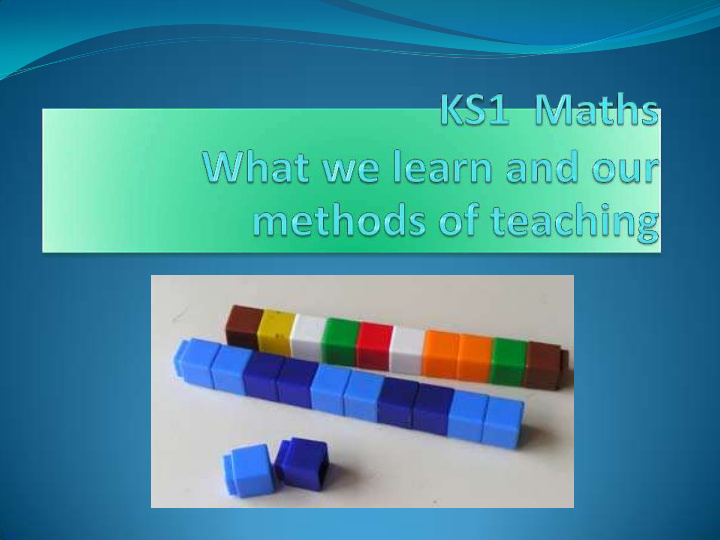



What do we teach in ks1 Maths? Number bonds from 10 and 20 ( ie 7+3=10, 18+2= 20) Basic multiplication ( 2,5,10) Basic division ( 2) Fractions ( ½ , ¼, 1/3 ) Addition and subtraction to 100 Place value ( units, tens and hundreds) Time ( o’clock, half past, quarter to, quarter past) Measurement ( weight, length, capacity) Money ( everyday money- calculating change) Problem solving Handling data ( graphing, tables, sorting data) Shape and space Today we will focus on the red highlighted examples
Resources Number line Number square Counters Online games Place value cards Unifix sticks
Place Value We use place value cards in combination with unifix cubes and 100 squares to recognize values of numbers. i.e. make the number 245 Step 1: separate the to its value 2 hundreds, 4 tens and 5 units Step 2: make that number with either cubes or a value card.
T.U.B Method 25 + 33= 58 Step 1: partition numbers ( tens 20 + 30) (units 5+3) Step 2: add up the Tens (T) ( 20 + 30 = 50) Step 3: add up the Units (U) ( 5+ 3 = 8) Step 4: add both (B) (50 + 8= 58) 55 + 26 ( T 50 + 20= 70) (U 5+6= 11) 70 + 11 = ( T70 +10= 80 ) (U 0+1=1) 80+1=81 Or UTB when carrying 1
Adding 5 + 3 = 8 Step 1 start on the biggest number and count on in jumps. Subtracting 18- 4= Step 1: start on the biggest number and count back in jumps.
Using a blank number line 34 + 25= 59 34 44 54 55 56 57 58 59 Step 1: partition 2 nd number ( 25- 2 tens (20) and 5 units) Step 2: jump the 10’s ( 2 tens) Step 3: jump the units ( 5)
Addition and Subtraction a with number square Adding 12 54 +12= 66 Step 1 :Partition the number ( one 10, two units) 10 & 2 Step 2: add on the 10 ( down 1) Step 3 add on the units ( right 2) Adding 10 go down 1 Subtracting 10 up 1 Adding 1go right 1 Subtracting 1 go left 1
Addition and Subtraction a with number square Adding 9 : 25 + 9= 34 Step 1: find 25 on number square Step 2: simplify the equation ( add 10 -1). To add 10 simple go down one on the number Grid then then take 1 to make 9 ( go left 1 space) Down 1 left 1 Subtracting 9: 25 -9= 16 Step 1: find 25 on the number grid Step 2: simplify the equation ( take 10 +1) Step 3: to take ten go up 1 then take 1 by going Right 1. Up 1 right 1
Using a number grid for patterns and multiplication Colour in the even numbers to recognize odd and even Learn the 2, 5 and 10 x table number square Variations for the number square Hiding numbers on a number square
Multiplication in ks1 First recognize that multiplication is repeated addition No of lots how many per group total 3 x 5 = 15 Is the same as 2 lots of 5 or 5 + 5 +5 = 15 Use pictorial cues to represent a x sum. Encourage them to write the sum: 5 + 5 + 5 = 15
Practical maths Making maths practical by using real materials. Try some of these at home with your child. Using coins using food Using measuring cups cooking
Online games Children love games to engage their learning. Try some of these site links.
Recommend
More recommend